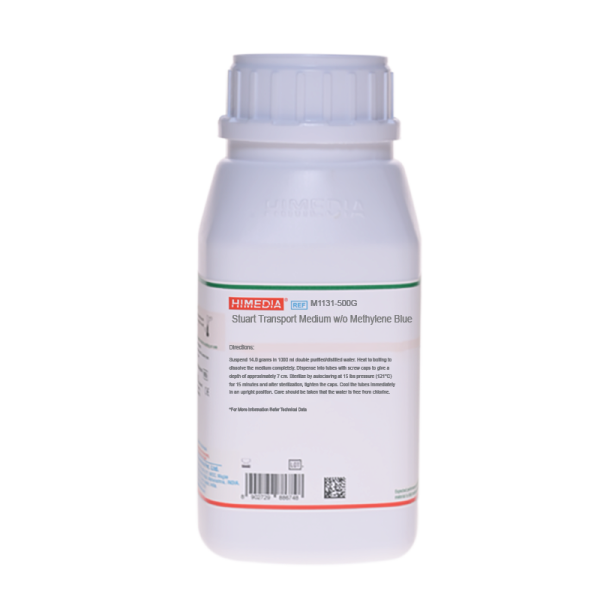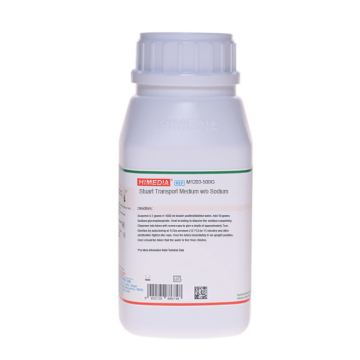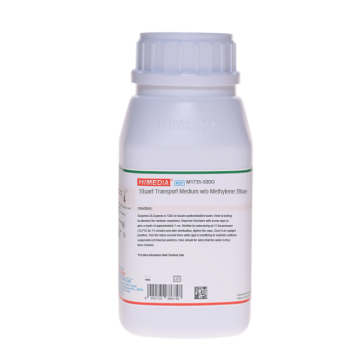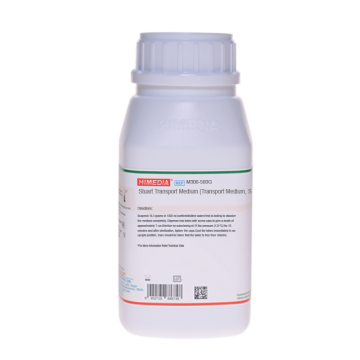 Your enquiry has been submitted
Your enquiry has been submitted
Stuart Transport Medium w/o Methylene Blue
Media For Transporting Clinical Specimens#CC293D
Intended Use:
Recommended for the preservation and transportation of Gonococcal species and other fastidious organisms from the clinic to laboratory.
Composition
| Ingredients | g/L |
|---|---|
| Sodium thioglycollate | 0.900 |
| Sodium ß-glycerophosphate | 10.000 |
| Calcium chloride anhydrous | 0.100 |
| Agar | 3.000 |
Final pH (at 25°C): 7.4±0.2
Formula adjusted, standardized to suit performance parameters
Directions
Suspend 14.0 grams in 1000 ml double purified/distilled water. Heat to boiling to dissolve the medium completely. Dispense into tubes with screw caps to give a depth of approximately 7 cm. Sterilize by autoclaving at 15 lbs pressure (121°C) for 15 minutes and after sterilization, tighten the caps. Cool the tubes immediately in an upright position. Care should be taken that the water is free from chlorine.
Principle And Interpretation
Stuart Transport media were originally designed by Stuart while studying Gonococci (1). Stuart et al (2) later on modified the Stuart Medium for the transportation of gonococcal specimens for culturing. Ringertz included thioglycollate in the Stuart Medium and omitted charcoal (3). This medium may be used for the transportation of many fastidious organisms including the anaerobes by maintaining organism's viability without significant multiplication (4). Crooks and Stuart (5) suggested the addition of Polymyxin B sulphate which facilitates the recovery of Neisseria gonorrhoeae.
This medium is chemically defined, semisolid, non-nutrient medium which prevent microbial proliferation. Because of it composition the medium ensures that microorganisms present are able to survive for a sufficiently long period of time. The medium provides adequate degree of anaerobiosis. Prepared sterile medium will undergo a slight degree of oxidation at the upper periphery of the medium. Calcium chloride alongwith sodium glycerophosphate act as good buffering agent and also maintains osmotic equilibrium in the medium.
Type of specimen
Clinical samples - Gonococcal specimens.
Specimen Collection and Handling:
For clinical samples follow appropriate techniques for handling specimens as per established guidelines (6,7). After use, contaminated materials must be sterilized by autoclaving before discarding.
Warning and Precautions :
In Vitro diagnostic Use only. For professional use only. Read the label before opening the container. Wear protective gloves/protective clothing/eye protection/face protection. Follow good microbiological lab practices while handling specimens and culture. Standard precautions as per established guidelines should be followed while handling clinical specimens. Safety guidelines may be referred in individual safety data sheets.
Limitations :
- Care should be taken that the water is free from chlorine.
Performance and Evaluation
Performance of the medium is expected when used as per the direction on the label within the expiry period when stored at recommended temperature.
Quality Control
Appearance: White to light yellow homogeneous free flowing powder
Gelling
Semisolid, comparable with 0.3% Agar gel.
Colour and Clarity of prepared medium
Colourless to whitish coloured slightly opalescent butt
Reaction
Reaction of 1.41% w/v aqueous solution at 25°C. pH: 7.4±0.2
pH
7.20-7.60
Cultural Response
Cultural characteristics observed after an incubation at 35-37°C for 72 hours when subcultured from Stuart Transport Medium.
| Organism | Growth | Subculture Medium |
|---|---|---|
| Haemophilus influenzae ATCC 35056 | good | Chocolate Agar (incubated in CO2 atmosphere) |
| Neisseria gonorrhoeae ATCC 19424 | good | Chocolate Agar (incubated in CO2 atmosphere) |
| Streptococcus pneumoniae ATCC 6303 | good | Tryptone Soya Agar with 5% sheep blood |
Storage and Shelf Life
Store between 10-30°C in a tightly closed container and the prepared medium at 5-30°C. Use before expiry date on the label. On opening, product should be properly stored dry, after tightly capping the bottle inorder to prevent lump formation due to the hygroscopic nature of the product. Improper storage of the product may lead to lurnp formation. Store in dry ventilated area protected from extremes of temperature and sources of ignition. Seal the container tightly after use. Product performance is best if used within stated expiry period.
Disposal
User must ensure safe disposal by autoclaving and/or incineration of used or unusable preparations of this product. Follow established laboratory procedures in disposing of infectious materials and material that comes into contact with clinical sample must be decontaminated and disposed of in accordance with current laboratory techniques (6,7).
Reference
- Stuart, 1946, Glasgow Med. J. 27:131.
- Stuart, Toshach and Patsula, 1954, Can. J. Public Health, 45:73.
- Ringertz, 1960, Acta Pathol. Microbiol. Scand., 48:105.
- MacFaddin J., 1985, Media for Isolation-Cultivation-Identification Maintenance of Medical Bacteria, Vol. I, Williams and Wilkins, Baltimore.
- Crookes E.M.L. and Stuart R.D., 1959, J. Path. Bact., 78:283.
- Isenberg, H.D. Clinical Microbiology Procedures Handbook 2nd Edition.
- Jorgensen, J.H., Pfaller, M.A., Carroll, K.C., Funke, G., Landry, M.L., Richter, S.S and Warnock., D.W. (2015) Manual of Clinical Microbiology, 11th Edition. Vol. 1.
| Product Name | Stuart Transport Medium w/o Methylene Blue |
|---|---|
| SKU | M1131 |
| Product Type | Regular |
| Physical Form | Powder |
| Origin | Chemically defined |
| Packaging type | HDPE |
| References | 1. Stuart, 1946, Glasgow Med. J. 27:131. |
| Customized Product Available | No |








